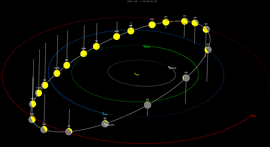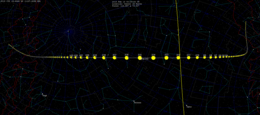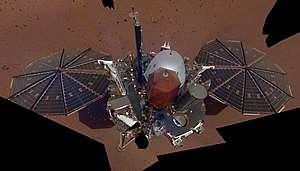2018 CY2
2018 CY2 is an asteroid, classified as a near-Earth object of the Apollo group, with an estimated diameter of 59–190 metres (190–620 ft). It was first observed on 9 February 2018, by astronomers of the Catalina Sky Survey at Mount Lemmon Observatory, Arizona, during its close approach to Earth.[1][2]
 The orbit of 2018 CY2 before and after flyby on 14 February 2018 | |
| Discovery [1][2] | |
|---|---|
| Discovered by | CSS |
| Discovery site | Mount Lemmon Obs. |
| Discovery date | 9 February 2018 (first observed only) |
| Designations | |
| 2018 CY2 | |
| NEO · Apollo [3][1] | |
| Orbital characteristics [3] | |
| Epoch 23 March 2018 (JD 2458200.5) | |
| Uncertainty parameter 7 | |
| Observation arc | 5 days |
| Aphelion | 1.3360 AU |
| Perihelion | 0.9211 AU |
| 1.1285 AU | |
| Eccentricity | 0.1838 |
| 1.20 yr (438 days) | |
| 338.04° | |
| 0° 49m 19.56s / day | |
| Inclination | 26.503° |
| 144.03° | |
| 73.482° | |
| Earth MOID | 0.0451 AU · 17.6 LD |
| Physical characteristics | |
Mean diameter | 59–190 m[4] 100 m (est. at 0.20)[5] 190 m (est. at 0.057)[5] |
| 22.33[3] | |
Orbit and classification
2018 CY2 is an Apollo asteroid. Apollo's cross the orbit of Earth and are the largest group of near-Earth objects with nearly 10 thousand known members. It orbits the Sun at a distance of 0.92–1.34 AU once every 14 months (438 days; semi-major axis of 1.13 AU). Its orbit has an eccentricity of 0.18 and an inclination of 27° with respect to the ecliptic.[3] It is, however, not a Mars-crossing asteroid, as its aphelion of 1.34 AU is less than the orbit of the Red Planet at 1.666 AU.[3] The body's observation arc begins its first observation at Mount Lemmon in February 2018.[1]
Close approaches
The object has a minimum orbital intersection distance with Earth of 6,750,000 km (0.0451 AU), which corresponds to 17.6 lunar distances (LD).[3] On 14 February 2018, 14:44 UTC, it came within 18.66 LD of the Earth (see diagrams).[4] Its next close approach will be on 14 February 2024, at a similar distance.[3]


Physical characteristics
The Minor Planet Center estimates a diameter of 59–190 meters.[4] Based on a generic magnitude-to-diameter conversion, 2018 CY2 measures between 100 and 190 meters in diameter, for an absolute magnitude of 22.33, and an assumed albedo between 0.057 and 0.20, which represent typical values for carbonaceous and stony asteroids, respectively.[5]
As of 2018, no rotational lightcurve of 2018 CY2 has been obtained from photometric observations. The body's rotation period, pole and shape remain unknown.[3]
Numbering and naming
This minor planet has neither been numbered nor named.[1]
References
- "2018 CY2". Minor Planet Center. Retrieved 15 February 2018.
- "MPEC 2018-C87 : 2018 CY2". Minor Planet Center. 12 February 2018. Retrieved 15 February 2018.
- "JPL Small-Body Database Browser: (2018 CY2)" (2018-02-14 last obs.). Jet Propulsion Laboratory. Retrieved 15 February 2018.
- Minor Planet Center. "2018 CY2". Twitter. Retrieved 12 February 2018.
- "Asteroid Size Estimator". CNEOS NASA/JPL. Retrieved 15 February 2018.
External links
| Wikimedia Commons has media related to 2018 CY2. |
- MPEC 2018-C87 : 2018 CY2, Minor Planet Electronic Circular
- 2018 CY2 at NeoDyS-2, Near Earth Objects—Dynamic Site
- Ephemeris · Obs prediction · Orbital info · MOID · Proper elements · Obs info · Close · Physical info · NEOCC
- 2018 CY2 at the JPL Small-Body Database

